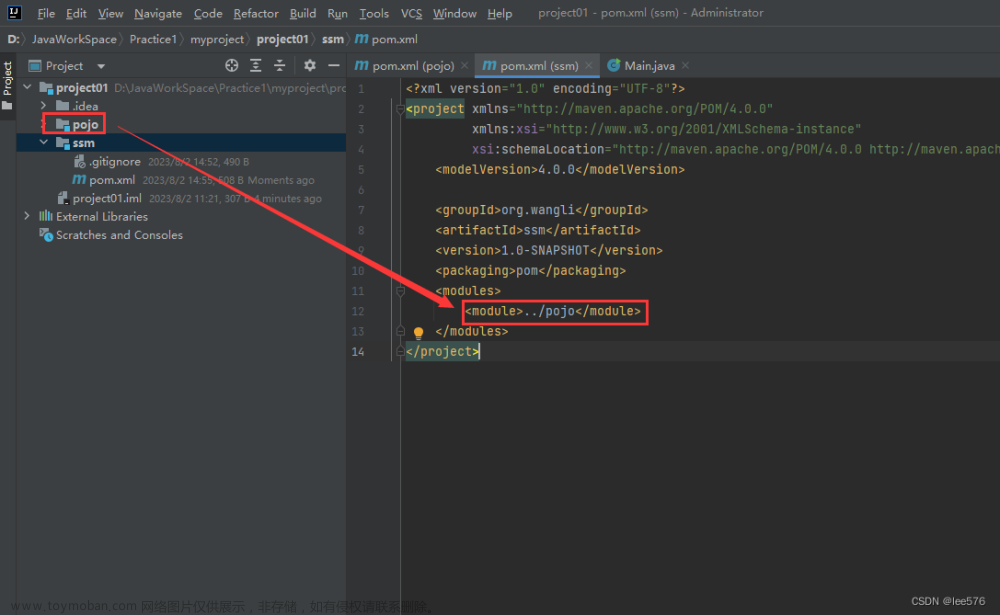1. 需求
最近有个需求: 要接收某个接口的 JSON 数据,而这个JSON数据有可能是一个 JSON 对象,也有可能是一个 JSON数组。
"{'name','王五','age':10}"
"[{'name':'张三','age':12},{'name':'李四','age':11}]"
现在呢,我需要根据传递过来的 JSON 数据进行判断,如果是对象就调用 resolve1(),如果是数组就调用 resolve2()。
依赖:
-
本文采用 fastjson 来处理 JSON 数据
<dependency> <groupId>com.alibaba</groupId> <artifactId>fastjson</artifactId> <version>1.2.83</version> </dependency> -
因为要处理 JSON 数组,所以要使用 JSONArray.parseArray
2. 测试
首先呢,要判断 JSON 数据是否是一个数组,那么我首先想到的是,我用 JSONArray.parseArray 会不会出现异常,如果出现了异常,那我 try-catch 一下,不是很简单就能实现了吗。
测试代码:
/**
* @author chenjy
* @description:
* @date 2023/1/11
*/
public class JSONTest {
public static void main(String[] args) {
String jsonArr = "[{'name':'张三','age':12},{'name':'李四','age':11}]";
String jsonObj = "{'name':'王五','age':10}";
JSONArray jsonArray = JSONArray.parseArray(jsonArr);
System.out.println(jsonArray);
JSONArray jsonObject = JSONArray.parseArray(jsonObj);
System.out.println(jsonObject);
}
}
控制台输出:
很显然,JSONArray.parseArray 转换 JSON 对象 的时候会抛出异常 com.alibaba.fastjson.JSONException,那么我们实现需求的思路就变得简单起来了。
兴趣使然,我再来看一下 JSONObject.parseObject 能不能转换 JSON 数组。
测试代码:
/**
* @author chenjy
* @description:
* @date 2023/1/11
*/
public class JSONTest {
public static void main(String[] args) {
String jsonArr = "[{'name':'张三','age':12},{'name':'李四','age':11}]";
String jsonObj = "{'name':'王五','age':10}";
JSONObject jsonObject = JSONObject.parseObject(jsonObj);
System.out.println(jsonObject);
JSONObject jsonArray = JSONObject.parseObject(jsonArr);
System.out.println(jsonArray);
}
}
控制台输出:
果然,也会抛出异常 com.alibaba.fastjson.JSONException。
3. 实现需求
好的,经过上面的测试,我们的需求实现思路:在 try 中调用 resolve2,在 catch 中调用 resolve1 。
/**
* @author chenjy
* @description:
* @date 2023/1/11
*/
public class JSONTest {
public static void main(String[] args) {
String jsonArr = "[{'name':'张三','age':12},{'name':'李四','age':11}]";
String jsonObj = "{'name':'王五','age':10}";
System.out.println("======测试 JSON 数组======");
getParam(jsonArr);
System.out.println("======测试 JSON 对象======");
getParam(jsonObj);
}
public static void getParam(String str) {
try {
JSONArray jsonArray = JSONArray.parseArray(str);
resolve2(jsonArray);
} catch (JSONException e) {
JSONObject jsonObject = JSONObject.parseObject(str);
resolve1(jsonObject);
}
}
/*
处理对象
*/
public static void resolve1(JSONObject obj) {
System.out.println("姓名:" + obj.getString("name") + "年龄:" + obj.get("age"));
}
/*
处理数组
*/
public static void resolve2(JSONArray array) {
for (Object obj : array) {
JSONObject jObj = (JSONObject) JSON.toJSON(obj);
System.out.println("姓名:" + jObj.getString("name") + "年龄:" + jObj.get("age"));
}
}
}

4. 相关操作
1. 将JSONObject装入JSONArray
我来形象地说明一下两者的关系文章来源:https://www.toymoban.com/news/detail-454012.html
- JSONObject 就相当于一个 Map,往 JSONObject 中新增键值对的方法: put(key, value),删除键值对的方法:remove(key)。
- JSONArray 相当于一个 List<Map>,往 JSONObject 中新增元素的方法: add(JSONObject),删除键值对的方法:remove(object)。
2. JSONArray与String的相互转换
- String 转 JSONArray → JSONArray.parseArray(String str)
- JSONArray 转 String → jsonArray.toString()、jsonArray.toJSONString()、String.valueOf(jsonArray)
顺便说一下 JSONObject 和 String 之间的相互转换文章来源地址https://www.toymoban.com/news/detail-454012.html
- String 转 JSONObject → JSONObject.parseObject(String str)
- JSONObject 转 String → jsonObject.toJSONString()、jsonObject.toString()、String.valueOf(jsonObject)
String jsonArr = "[{'name':'张三','age':12},{'name':'李四','age':11}]";
String jsonObj = "{'name':'王五','age':10}";
JSONArray jsonArray = JSONArray.parseArray(jsonArr);
System.out.println(
jsonArray.toJSONString() instanceof String
&& jsonArray.toString() instanceof String
&& String.valueOf(jsonArray) instanceof String
);
JSONObject jsonObject = JSONObject.parseObject(jsonObj);
System.out.println(
jsonObject.toJSONString() instanceof String
&& jsonObject.toString() instanceof String
&& String.valueOf(jsonObject) instanceof String
);
3. 注意:toString与JSONObject.toJSONString的区别
public class JSONTest {
public static void main(String[] args) {
Tom tom = new Tom("张三", 18);
System.out.println(tom.toString());
JSONObject jsonObject = JSONObject.parseObject(JSONObject.toJSONString(tom));
System.out.println(jsonObject);
jsonObject.put("sex", 1);
System.out.println(jsonObject.toJSONString());
}
}
@Data
@AllArgsConstructor
class Tom {
String name;
Integer age;
}

到了这里,关于JSONArray与JSONObject的文章就介绍完了。如果您还想了解更多内容,请在右上角搜索TOY模板网以前的文章或继续浏览下面的相关文章,希望大家以后多多支持TOY模板网!







